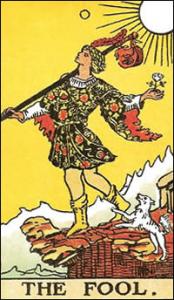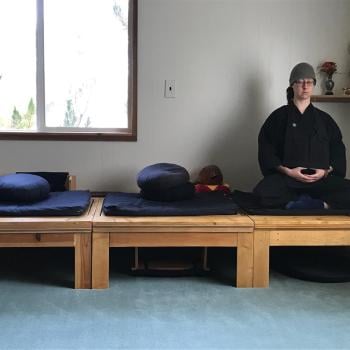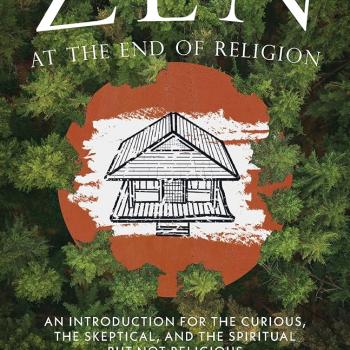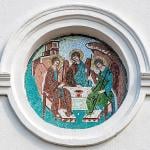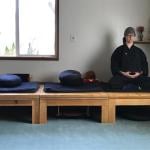Zen priest Claire Gesshin Greenwood asked on Facebook what exactly was the source of the oft cited bit of Zen counsel that life or training or Zen itself is “one continuous mistake”?
It led to various thoughts and suggestions, some of them even informed. Facebook is like that.
Some opine she was offering a koan.
In all likelihood the source of that particular phrase is the Zen master Shunryu Suzuki, who wrote in Zen Mind, Begninner’s Mind:
“When we reflect on what we are doing in our everyday life, we are always ashamed of ourselves. One of my students wrote to me saying, “You sent me a calendar, and I am trying to follow the good mottoes which appear on each page. But the year has hardly begun, and already I have failed!” Dogen-zenji said,’ ‘Shoshaku jushaku.” Shaku generally means “mistake” or “wrong.” Shoshaku jushaku means “to succeed wrong with wrong,” or one continuous mistake. According to Dogen, one continuous mistake can also be Zen. A Zen master’s life could be said to be so many years of shoshaku jushaku. This means so many years of one single-minded effort.”
Then, adding a little frost to the snow Zen priest Genjo Conway offered how Zen master Shohaku Okumura noted “one continuous mistake” is most likely specifically paraphrased from Dogen’s fascicle Gyobutsu Igi:
“進歩也錯、退歩也錯、一歩也錯、両歩也錯なるがゆゑに錯錯なり。
Stepping forward is a mistake; stepping backward is also a mistake, taking one step is a mistake, taking two steps is also a mistake; therefore one mistake after another mistake. [Whatever we say is a mistake.]
“天地懸隔するがゆゑに至道無難なり。
Because the separation is as great as that between heaven and earth, the ultimate Way is not difficult.
“威儀儀威、大道體寛と究竟すべし。
We should conclude that dignified conduct is conducting dignity, and the essence of the great Way is boundless.”
And, of course, there is that koan thing. A koan is an assertion about reality together with an invitation to take that place. Take your place.
The Gateless Gate is my favorite anthology of koans. Compiled in the Twelfth century by Master Wumen, the thirty-eighth case is quite brief, and I suggest to the point of that mystery that I one continuous mistake.
Wuzu Fayan said, “It is like an ox that passes through a latticed window. Its head, horns, and four legs all pass through. So, why can’t its tail also pass through?”
That’s it. That’s the koan. To help a little good old Wumen throws in the briefest of sermons.
“If you can get upside down with this one, discern it clearly, and give a turning word to it, then you can meet the Four Obligations above and give comfort to the Three Existences below. But if it is not yet clear, pay close attention to this tail and you will resolve it at last.”
Our four obligations are to our family, to our community, to all beings and to the great way. The three existences are past, present and future. So, finding the upside down and penetrating to its deepest core heals the whole world right to the depths of deepest time. And, then, together with that assertion we are invited to pay attention to the tail in this metaphor of an ox escaping through a window. And, of course, that one other thing.
So, what is the Ox? And what about that tail? And, what does this have to do with mistakes?
Perhaps the greatest of all koan masters, Hakuin Ekaku, ruminating in the eighteenth century suggested this particular koan was one of the thorniest, one of most difficult of them all. Now, from the inside of koan work, this isn’t strictly true. To give an acceptable response for this case to a teacher of koan Zen is in fact pretty straightforward. However, to understand it down to the bottom of our feet, all the way down, to find it penetrate through blood, bone and marrow; that is the hard part.
So, what about the easy? And then, what about the difficult? And, where are the mistakes?
Let’s start with easy. The question is put to us by the master Wuzu Fayan. He’s one of those trickster figures about whom we never know quite enough, but he keeps popping up in our lives. Wuzu means “Fifth Ancestor,” but he isn’t the fifth ancestor of the Chinese inheritance who is Damen Hongren. Wuzu lived through the last three quarters of the eleventh century, dying just at the beginning of the twelfth.
For me he is particularly interesting because the driving question, the heart koan of his life came out of a conversation with a Sutra master whom he asked about awakening, and was told “it is like drinking water and knowing for oneself whether it is warm or cold.”
Wanting to know that taste for himself, Wuzu launched into the great way. I’ve used that line over and over as the great invitation of the Zen way – to know for our selves, for your self, for my self, what is and what is not. At least so far as the great matters of the heart are concerned, the questions that tumble out of us and our knowing we are born and we shall die.
After Wuzu resolved the question for himself he went on to teach. One of his students was Yuanwu the editor of the Blue Cliff Record, and a few generations later in his line we are given Wumen, the editor of the Gateless Gate.
Clearly in this koan with the ox and its tail we are given a metaphor. It’s fair to suggest this ox is the same ox used in that wondrous map of the way of awakening called the Ten Oxherding Pictures. According to my teacher’s teacher this ox “pulls the plow through the mud of the rice fields and enriches them with its manure. Its power and placid disposition give it a place in the Buddhist pantheon with (Manjushri’s) lion and (Samantabhadra’s) elephant.” In the oxherding pictures it represents our Buddha nature.
Buddha nature. So, what is this Buddha nature we’re supposed to know so intimately? What is that Buddha nature that is like having come to sip that water, and knowing for ourselves whether warm or cool?
First, there’s what we know with our senses. Here is the flow of cause and effect, where we are woven out of many things, and we ourselves by our actions and intentions add new strands to the great web. It is real. Pinch yourself, and you’ll know it is so. And, that’s a mistake.
Here we also can come back to the Buddha’s assertion of no self, no essence, and at the same time telling stories of lifetime after lifetime that certainly looks like something with an essence. Of course, that’s another mistake.
What I find in this is how that emptiness that is as much a part of anything as the thing of it is experienced in our lived lives. We experience emptiness as something. Which, is one more mistake.
On my way the encounter has had three manifestations. First, there was that separation. I feel it. I know I’m not you. And neither of us is the wall that we face in zazen. Of course, that’s a mistake. Then, through some miracle one comes to a noticing, realizing it viscerally, deeply, truly – that I am connected to you. And you to me. And both of us to that wall we face in zazen. Still one more mistake.
And so much more. A mistake. And then another. And, well, it turns out one continuous mistake.
And with that mysteries are revealed. There are no nouns. In fact the world is constantly verbing. All those lives are this life. Self. Other. One. The Great Empty.
And with that words collapse. And in a heartbeat. Here we are. You. Me. The wall.
And everyone one of them a mistake.
So, that question. There’s this ox. It has passed through the latticed window. Horns. Head. Shoulders. Front legs. Body. Back legs. Everything. Except that little tail.
Why is that? There’s the easy answer. It “passes” the koan. Of course that’s a mistake.
Then there’s the next part. Taking it out into the world of our lives. Where we are separate. Where we are one. Where we are completely, totally, wildly ourselves. Verbing. Mistaking. Dancing in and out of the universe. More mistakes.
One continuous mistake.
Something mysterious, and, frankly, dangerous at the heart of our Zen way.
One continuous mistake.
The course of our lives.
One continuous mistake.


